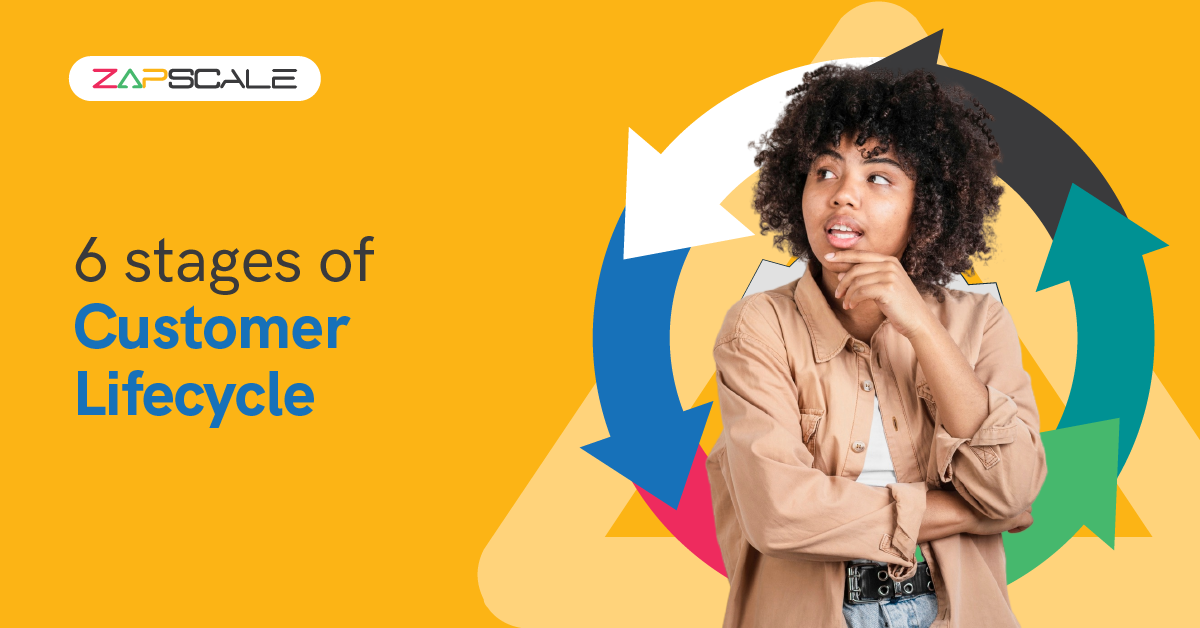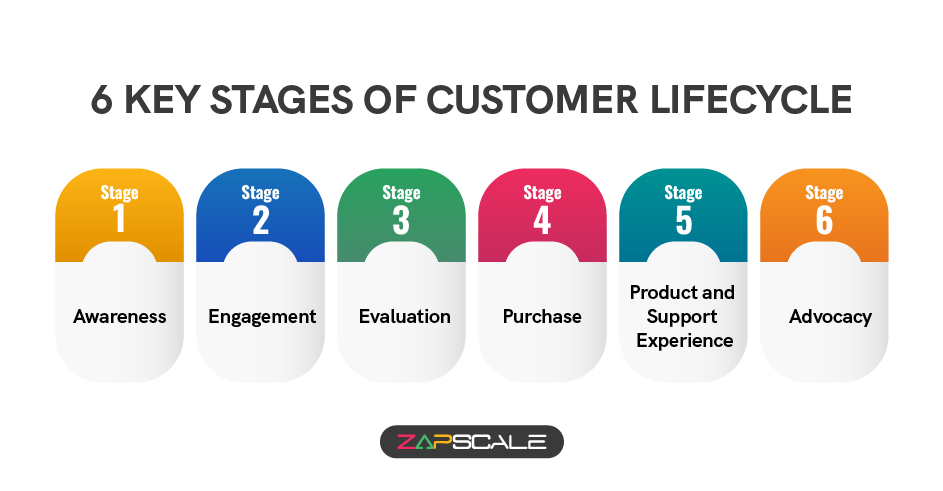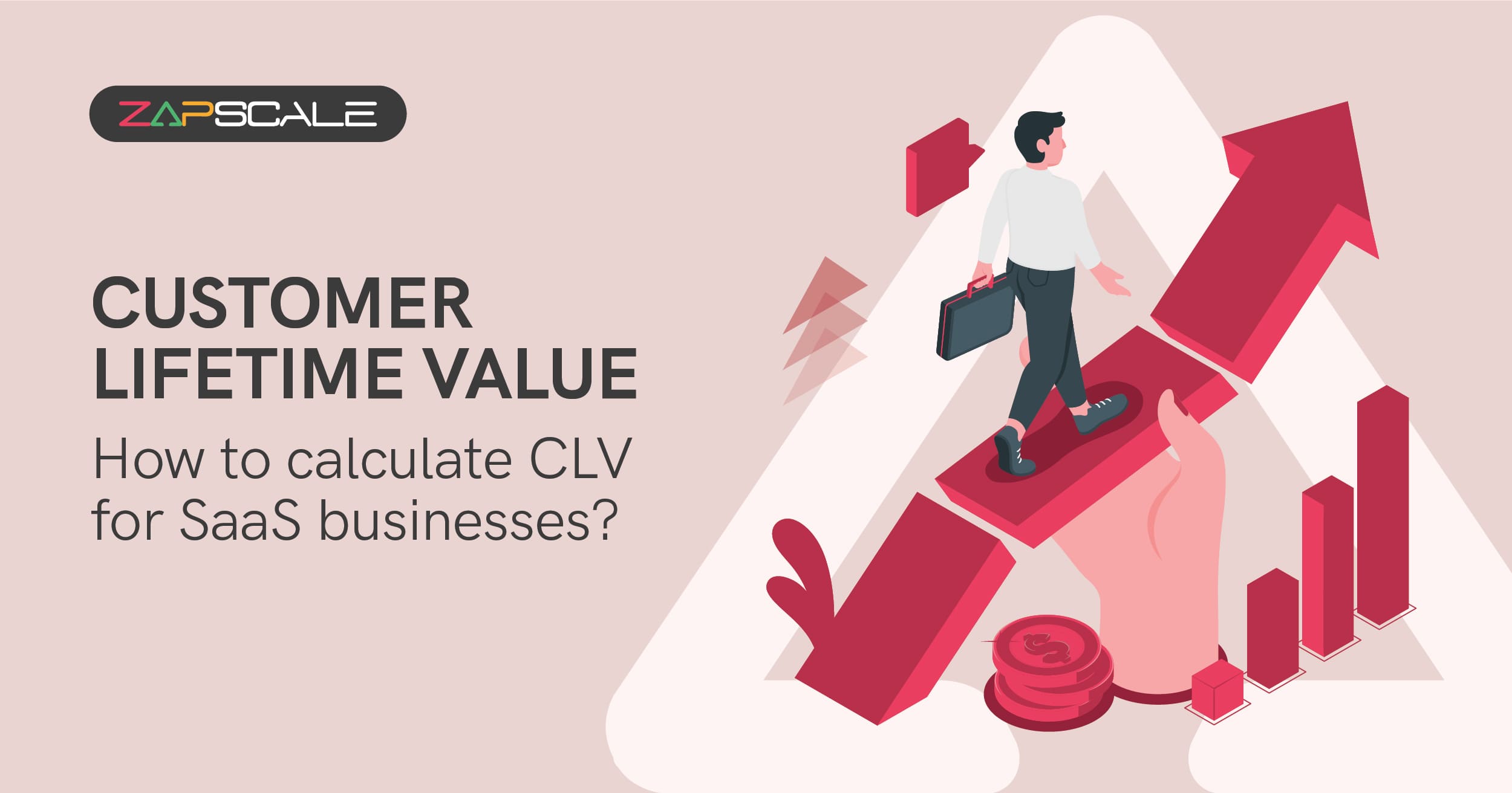CATEGORY > Customer Lifetime Value
Decoding Stages of Customer Lifecycle for SaaS Success

In a SaaS landscape, it’s vital to go over the board with customer-centricity as customers are the backbone of any SaaS establishment. One way to achieve the same is by understanding the stages of the customer lifecycle.
Now, what do I mean by that? Read further to learn more.
The Lifecycle of a SaaS Customer - A Complete Overview
Customer lifecycle is the journey that a customer takes from first discovering your product to becoming a dedicated advocate.
It involves some distinct stages that we’ll discuss in this blog today.
Each stage of the customer lifecycle is essential for augmenting the overall CX (Customer Experience) and CS (Customer Success).
Once your customers become interested in your product and commit to a subscription, it becomes your responsibility to ensure that they have a smooth onboarding experience. Your CS (Customer Success) team must assist users during the initial phases by successfully integrating the software into their daily routines. As customers begin to use your product, their pleasure and ongoing engagement become critical. Your goal is to give continuing support and enhancements that keep them satisfied while minimizing the possibility of them switching to a competitor.
Finally, the Customer Lifecycle involves converting delighted customers into committed advocates who promote your product and contribute to its success. Understanding and efficiently managing this lifecycle contributes to customer retention and growth through upselling, renewals, and good referrals.
The Power of Customer Lifecycle for SaaS Profitability
Having a practical Customer Lifecycle can open many doors of opportunities for a SaaS business. Let’s find out some proven advantages of incorporating a Customer Lifecycle plan across your organization.
1. Stronger Customer Relationships
Monitoring the Customer Lifecycle provides additional insights into customer requirements and habits. This intelligence enables organizations to adapt interactions and replies, exhibiting genuine concern for customers' demands. As a result, customers feel more valued and have a stronger, more personal relationship with the SaaS company.
2. Accelerated Customer Acquisition
We all know that a well-managed customer lifecycle gives significant information about customer behavior and preferences. By analyzing these facts, SaaS business owners might enhance their marketing tactics, better target the correct demographic, and boost the efficiency of their customer acquisition efforts.
3. Personalized CX (Customer Experience)
Being aware of where customers stand in their lifecycle enables SaaS brands to tailor their interactions and products. Tailoring messages, recommendations, and support based on customer data improves the whole experience, increasing happiness and loyalty.
4. Higher Customer Retention
Understanding and improving the stages of the customer lifecycle not only allows SaaS organizations to personalize interactions and offer support to their customers but also keeps them hooked to the brand. Effective management of each stage, from onboarding to continuing support, enables rapid response to customer queries or concerns, lowering churn and increasing retention rates.
5. Stronger Customer Base
Regular monitoring of the Customer Lifecycle contributes to the development and maintenance of a healthy customer database. This database gives vital information to the sales staff, allowing for more strategic meeting scheduling, better customer relationship management, and enhanced issue resolution.
6. Efficient Resource Allocation
Managing the Customer Lifecycle makes it possible for SaaS organizations to allocate resources more efficiently. Companies that identify high-value customers and understand their needs can focus their efforts on areas with the most impact, maximizing their investment in customer success and support.
7. Increased Profitability
An in-depth understanding of stages of the Customer Lifecycle has a substantial impact on profitability. With a promising Customer Lifecycle, SaaS firms can increase productivity, reduce sales cycles, and find possibilities for upselling and cross-selling by optimizing interactions and streamlining processes, resulting in high revenue growth.
Diverse Stages of Customer Lifecycle - A Step-by-Step Breakdown
There are multiple stages of the customer relationship lifecycle that you must acquaint yourself with if you wish to serve your customers optimally.
Let’s learn about the top 6 stages of the customer lifecycle in the simplest way possible.

Stage 1: Awareness
Before buying any of your products or services, the customer must know about your brand first so that they know what they’re getting into. This stage is called the “Awareness” stage, a stage in which your potential customers learn about your brand or products for the first time.
At this point, people are only becoming aware of your existence and learning about your offerings. This happens through a variety of channels, including online ads, social media posts, and word-of-mouth referrals. The idea is to build a powerful brand image that piques people's interest in what you have to offer. One method to do so is by capturing their attention and leaving a lasting impression. Ultimately, you want people to see your brand as a solution to a problem they have or as a desired option in their market. Good marketing methods, clear messaging, and compelling content are some proven ways that make a difference in the way people perceive you.
Stage 2: Engagement
Once potential buyers become aware of your brand, they enter the Engagement stage. At this stage, they begin to proactively interact with your brand by visiting your website, subscribing to your newsletter, or following you on social media. The purpose of this stage is to develop a relationship with them.
You want to provide useful content, respond to their questions, and engage them with relevant information. By doing so, you demonstrate that you understand their problems and are prepared to provide solutions, which fosters trust and keeps them engaged in what you have to offer.
Stage 3: Evaluation
Next comes the Evaluation stage - a critical stage where potential customers become “real customers”. This stage determines if your potential leads are ready to convert or not. Users at this particular stage compare your product or service to alternatives, read reviews, and consider the advantages and disadvantages. Your objective during this stage must be to help them understand why your product is the best option in the market.
Offering clear comparisons, showcasing unique benefits, and addressing any concerns can persuade them to choose you over your competition. The goal is to deliver all of the information potential customers need to assist them in making an informed decision. Win them over with positive testimonials, free trials, and exciting discount options.
Stage 4: Purchase
The Purchase stage occurs when a customer agrees to buy your products or services. This is when their interest turns into action. Making this process as easy as possible is critical to ensure a confirmed transaction. Double-check that your purchasing procedure is simple, secure, and user-friendly. Providing several payment alternatives, clear instructions, and prompt customer service can reduce friction and prevent complications that may hold back a transaction.
Stage 5: Product and Support Experience
Following the purchase, customers enter the Product and Support Experience stage. This is where customers will use your product or service and, if necessary, communicate with your support team. A great experience here is critical to ensure customer happiness.
Providing exceptional customer service, fixing any issues, and actively soliciting feedback all assist in guaranteeing that customers are satisfied with their purchase. A positive experience during this stage might result in recurring business and a strong, loyal customer base. Always make sure that the product or service fulfills what it promises.
Stage 6: Advocacy
The final stage of the Customer Relationship Lifecycle includes the “Advocacy” stage. During the Advocacy stage, satisfied customers become loyal champions for your brand. They are so satisfied with their experience that they begin recommending your products to others.
They may do so by offering positive comments, discussing their experiences on social media, or telling their friends and family about your business. This stage is valuable because it converts your consumer base into enthusiastic ambassadors who help attract new customers.
Encouraging this type of word-of-mouth marketing by paying referrals or simply thanking people for their support will help sustain the advocacy momentum and build your brand's reputation.
FAQs
Q. Why is understanding the Customer Lifecycle useful for SaaS companies?
A: By Understanding the Customer Lifecycle, SaaS brands can better improve customer relationships, tailor experiences, increase retention, and boost profitability.
Q. How can a SaaS brand use customer feedback effectively?
A: SaaS businesses can utilize feedback in terms of product improvement, proactive customer service, and enhance the overall customer experience to boost satisfaction and loyalty.
Q. What role does personalized experience play in the customer lifecycle?
A: Customers feel appreciated and satisfied when they receive personalized experiences, which can lead to increased retention and advocacy.
ABOUT THE AUTHOR
Popular from Customer Lifetime Value
Quality Content,
Straight To Your Inbox!
Subscribe for the latest blogs, podcasts, webinars, and events!

Write a Blog
If you have experience in CS and
a flair for writing, we’d love to
feature you.
Write to us on
hello@zapscale.com



